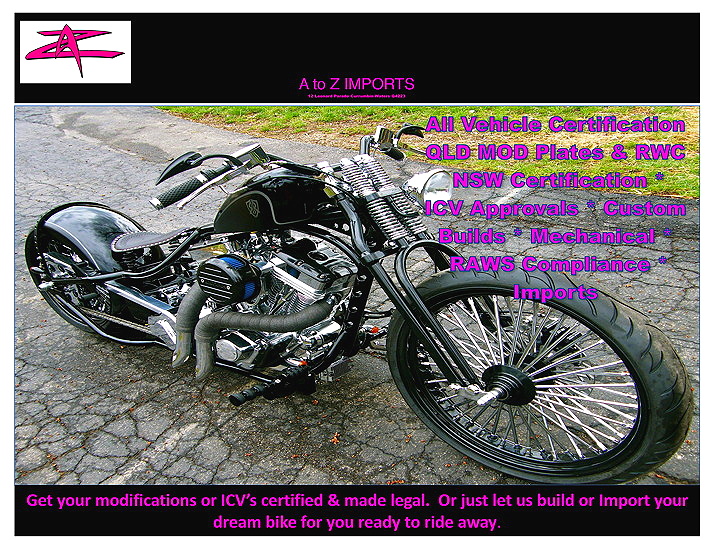
Knucklehead By Special Request—Part 3
These days there’s a trend towards old school machines but with a little sophistication added—what could be more appropriate than a rigid Knucklehead with a six-speed transmission, electric start and rear belt-drive.
THIS ISSUE we will be concentrating on bringing all the basic items together—the Knucklehead engine, the Spyke six-speed transmission with the Genuine H-D primary drive and chaincase.
We will start with a brand new, fresh out of the box, pair of Knuckleheads which will be stripped and glass beaded. Valve guide clearances will be checked and oil return pipes examined to confirm that they are clear. The heads will then be thoroughly washed, masked and painted in two-pack silver.

Brand new Knuckleheads to be stripped and bead blasted.

The heads were stripped and painted in two-pack silver.

The bare heads can now be temporarily installed and the top-engine-mount assessed. As the cylinder heads have not been on an engine before, and as the bike is a special-build, there is a chance that the stock Knucklehead top-engine-mount will not line up with the universal mount on the Santee frame.

The knucklehead top-engine-mount is secured to the cylinder heads via the intake rocker-arm shafts. For mock-up purposes the rocker-arm shafts are installed without the rocker-arms. Stock top-engine-mount can then be bolted up in the usual manner.

As we suspected, the original top-engine-mount does not reach the mount on the frame even though it has a generous slot. Rather than alter the classic Knucklehead bracket, it is decided to extend the existing frame mount. The mount can be cut through the centre of the slot, creating a notch; a matching tab on the replacement piece will key right in.
Another advantage of using the stock top-engine-mount is that it will accommodate the original choke mechanism if a Linkert carburetor is used.

A cardboard template of the extension required to the frame mount.

The new extension piece cut from a piece of matching 10 mm plate ready to be grafted in. Once TIG welded this new mount will be equally as strong as the original. The cutting and welding will all be undertaken after the engine is removed.

Heads can now be reassembled and installed.
That is it for the engine; all aspects of this installation have been covered. The owner will now need to select the exhaust system, fuel tank and anything else that could require special brackets, etc, before the whole thing can be torn down for blasting, detailing and painting.

Moving onto the rear brake, the first thing to do is to centre the rear hub which is done using the string-line we set up at the beginning of the project. The string-line runs from the centre of the steering stem and follows the backbone of the frame through to the precise centre of the building jig. This forms the centreline of the bike and all calculations and offsets are done in relation to this.

The rear hub prior to being laced to the rim is set up on the exact centreline of the bike. With the hub in the correct location and the rear pulley less disc and caliper in place, it is obvious that this system is going to work very well with this particular frame. Note the location of the rear axle in its slot, with belt tension set; this is ideal.

The rear hub is positioned using this simple timber jig that straddles the two spoke flanges.
At this stage the rear hub is mounted on a piece of ¾-inch tube, the same diameter as the rear axle which will be made to the correct length from special axle steel at the completion of the mock-up. A special spacer will need to be machined and installed between the pulley and the hub to give correct alignment for the drive belt in relation to the transmission. We made the calculations for the spacer thickness in Part ll after the transmission installation was completed. The reason for this is that the high-tech rear brake set-up is made for a Softail which is quite different in the rear end than our rigid frame. With the location of the rear hub finalised, correct length axle spacers can be machined to complete the installation.

With the caliper installed onto the pulley and the spacer in place, the anti-rotation arm needs to be considered. This anchors the caliper to the frame, but will need some form of adjustment to allow for alterations in belt tension.
This nifty little clamp can be positioned on the frame tube. Eventually it will be replaced with a small slotted tab welded directly to the frame for a much cleaner look.

The slotted tab that will be welded under the frame tube to replace the clamp.

The placement of the hydraulic hose to the rear caliper is extremely important and there are a few things to consider. The hose needs to be out of reach of mechanical damage and should not be below or outside of the frame tube. In this case it will need additional length to provide enough room for drive belt adjustments. This is the hose supplied with the kit, fully certified for street use, and as the Softail swing-arm and the rigid frame are very similar in profile, this hose suits this application very well.
Chalk marks indicate locations where inconspicuous clips will be welded directly to the frame during the detailing leading up to paintwork.
This completes the basic customer requirements to bring the bike to this stage knowing that when he assembles it after paint, chrome plating, etc, everything will fit and lineup perfectly.
Make sure you check out the previous articles: Knucklehead By Special Request—Part 1 and Knucklehead By Special Request—Part 2.
compiled by Richard Nicholls at Redgrave Motorcycles.

